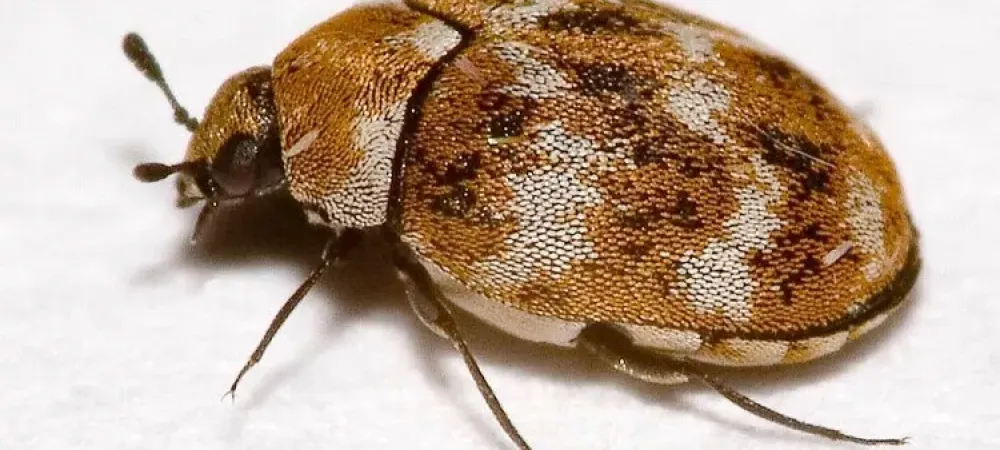How to Find Carpet Beetles

What is a Carpet Beetle?
The carpet beetle belongs to the Dermestidae family. They are a common species, often considered a pest of domestic houses and, particularly, natural history museums, where the larvae may damage natural fibers and can damage carpets, furniture, clothing, and insect collections.
What Does a Carpet Beetle Look Like?
These beetles vary in size, with most species ranging from 1-4 millimeters in length. They have an oval-shaped body that is covered in tiny hairs, giving them a fuzzy appearance. Carpet beetles come in a variety of colors, including black, brown, and mottled patterns.
One of the most distinguishing features of carpet beetles is their larvae, which are often the cause of damage to household items. Carpet beetle larvae are small, worm-like creatures with bristles on their bodies. They are typically brown or tan in color and can be found feeding on natural fibers such as wool.
How Do I Get Carpet Beetles?
The Carpet Beetle has a diet of fabric and animal products and thrives in homes if left alone. Adults can fly inside through open doors and windows. They can lay eggs on furniture, clothing, rugs, and carpet and often are introduced when infested items are brought inside a home.
How Do I Find Carpet Beetles?
Identifying Carpet beetles correctly is important so that you can implement elimination immediately and effectively. Most adults are oval-shaped, black with white, yellow, and at times, orange patterns, and grow up to 1-4 mm in length. Beetles move slowly and roll over when touched. Black Carpet bugs are the most dangerous as they can destroy your property. Varied carpet bugs are smaller than the black ones. Common Carpet Bugs are round, black, or yellow bugs. Larvae of these bugs often attack carpets and can also eat woolens, silk, furs, and feathers. When it comes to furniture, carpet bugs are usually found on furniture where they like to feed on padding, hair, and feathers.
Here are the signs that you may have carpet beetles:
- Thin, bare areas on wool or wool-blend rugs.
- Damage to wool clothes, blankets, etc.
- Hairs falling out of furs.
- Shed larval skins in hidden areas.
- Tiny beetles slowly climbing walls or dead at windowsills.
- Rash on your skin from contacting the tiny hairs or bristles found on carpet beetles.
Adult carpet beetles are attracted to light and can be found near light fixtures and window sills. Remember, carpet beetle larvae cause damage, not adult carpet beetles, so if you see adult carpet beetles in the home, you should look in dark areas for larvae.
How Do I Get Rid of Carpet Beetles?
Vacuuming
First of all, vacuum your carpet, furniture, and curtains. Inspect the floor and pick up things from it that can be infested by these bugs. Wash everything in warm water. Regular laundering and vacuuming of carpets, linens, and furniture can really help to battle bugs.
Prevention Spray
Purchase a prevention spray for carpet bugs. Boric Acid. Another effective method is spreading boric acid onto the fabric furniture and the carpet. In this way, you will have the greatest opportunity to kill all the living bugs’ larvae and prevent an infestation from the new ones. You can find boric acid in different pest-control stores. The acid attaches to the bug’s body and kills it after the bug ingests it. Having low toxicity, the acid is not harmful to humans and is the most popular and recommended treatment for dealing with Carpet Beetles.
Mothballs
Pack and store your clothes and fabrics in boxes with mothballs. If used correctly it can be really beneficial.
Professional Pest Control Services
Treating correctly is very important, so hiring a professional may cost you a little more money than trying to do it yourself, but this way, you will get the best treatment options and removal of the beetle infestation. Fenn Termite & Pest Control, Inc. is the choice for professional pest control in Los Angeles, Santa Monica, and surrounding Southern California communities. We always offer green pest control options and our pest control specialists have the training, experience, and resources to assure protection from and solutions for all types of destructive pests.